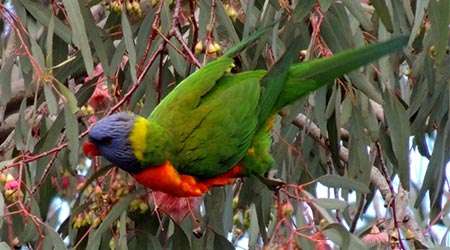Certain Australian native flowers have evolved their flower colour to red hues favoured by birds

(Phys.org)—In a study just published in New Phytologist, researchers from RMIT and Monash universities have shown for the first time that Australian native flowers exclusively pollinated by birds have evolved colour spectral signatures that are best discriminated by those birds.
Adrian Dyer, Associate Professor of Photography in the RMIT School of Media and Communication, said previous studies had shown that flower colour evolved to attract bees as pollinators.
"We know that some flowers had evolved spectral signatures to suit bee pollinators, but the story for bird-pollinated flowers was not clear," he said.
Mani Shrestha, lead author and PhD student from the Monash School of Biological Sciences, collected spectral data from more than 200 flowering plants and identified the pollinators as birds or insects.
Then with Associate Professor Martin Burd, also from the Monash School of Biological Sciences, Mr Shrestha did phylogenetic analyses to identify how the flowers evolved spectral signatures.
Mr Shesthra said they found that flowers exclusively pollinated by birds had initially evolved to suit insect vision.
"But more recently the spectral signature of bird-pollinated flowers had shifted towards longer wavelengths," he said.
The research showed that rather than just having any type of red reflection, bird-pollinated flowers targeted the specific wavelengths that best matched the long wavelength tetrachromatic (four colour) vision of many Australian native birds.
Mr Shresthra said that bird-pollinated flowers may have evolved red signals to be inconspicuousness to some insects that were poor pollinators, while also enhancing the discrimination of bird pollinators.
Associate Professor Burd said the work had broad significance for understanding how flower colours evolved to suit specific pollinators, and how colour might continue to evolve in particular environments depending on the availability of effective pollinators.
"The colour cues in Australian flowers would be easily detected by honeyeaters, the most important family of nectar feeding birds in Australia," he said.
"Hummingbirds in the Americas have similar visual systems to honeyeaters, so we expect to find similar colour signals among American flowers.
"But in Asia and Africa, birds with a different type of colour vision are the primary avian pollinators.
"If flower colours in these regions are tuned to the specific capacities of their own birds, we would have strong evidence that we've cracked the code that plants use to communicate with birds."
More information: onlinelibrary.wiley.com/doi/10 … 1/nph.12135/abstract
Journal information: New Phytologist
Provided by RMIT University





















